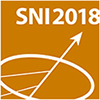Speaker
Description
The exchange bias effect refers to the unidirectional shift of the hysteresis loop of a magnetization curve, conventionally that of a ferromagnet in direct contact to an antiferromagnet. Chiral magnetism, on the other hand, that manifests in the existence of skyrmions or chiral domain walls, offers an alternative way for creating anisotropies in magnetic materials that might have large potential for being used in future spintronic devices. Alloys of rare-earth elements and 3d transition metals (RE-TM) became recently in the focus of attention due there rich variety of magnetic effects owed to the different anisotropies of both material classes [1-4].
Here we show experimental evidence for a new type of in-plane exchange bias effect present at room temperature that is created from a chiral 90° domain wall at the interface of a ferrimagnetic RE-TM (DyCo) layer in contact to a ferromagnetic (NiFe) layer at room temperature. The chiral interfacial domain wall in the here presented system forms due to the presence of macroscopic Dzyaloshinskii-Moriya interaction in the ferrimagnetic layer and its orthogonal exchange coupling to the ferromagnetic layer at the interface.
As a consequence of the fixed chirality of the interfacial domain wall, the shift of the hysteresis loop can be reversed by changing the orientation of the out-of-plane magnetization of the ferrimagnetic layer. The chirality created tunable exchange bias is very robust against high in-plane magnetic fields and does not show any aging effects after multiple reversals of the exchange bias direction, therefore, it overcomes the limitations of conventional exchange bias systems.
Such chirality based EB systems may be of crucial importance for the development of future applications in the field of magnetic sensors and data storage devices.
[1] S. Mangin et.al, Phys. Rev. B 80, 224424 (2009), S. Mangin et.al, Phys. Rev. Lett. 82, 4336 (1999).
[2] Chen, K., Lott, D. et al., Phys. Rev. B 91, 024409 (2015).
[3] Chen, K., Lott, D. et al., Sci. Rep. 5, 18377 (2015).
[4] F. Radu, R. Abrudan, I. Radu, D. Schmitz, H. Zabel, Nat. Communications 3, 715 (2012).

